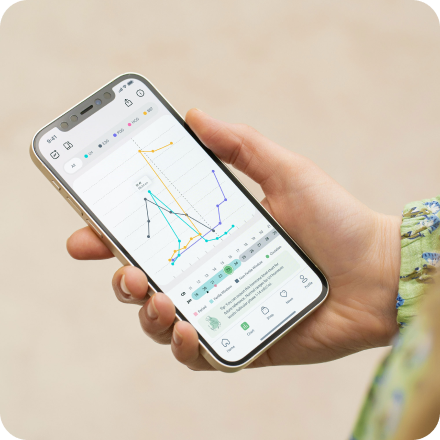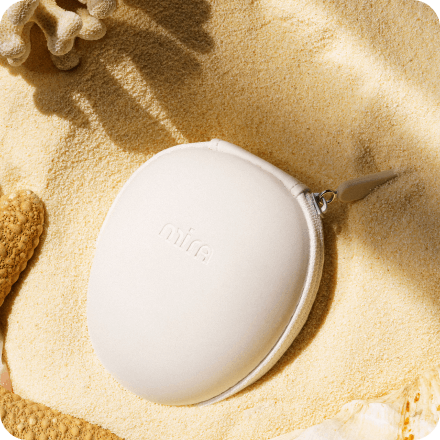Progesterone Levels: What’s Normal for Women?
Progesterone plays a vital role in women’s reproductive health. However, the dynamic nature of this hormone can make it difficult to understand what “normal” progesterone levels are along your fertility journey.

In this article, we will explore what progesterone is, what it does in the body, and where your progesterone levels should be. We’ll also take a look at ways you can test your progesterone levels, and what to do if your levels are too high or too low.
What are normal progesterone levels in women?
In women, blood serum progesterone levels can range from as low as <= 0.20 ng/mL to as high as 200+ ng/mL. However, what is considered “normal” can depend on a number of factors including menstrual cycle phase or stage of menopause.
In women with regular menstrual cycles, progesterone levels tend to stay below 0.89 ng/mL before rising to 1.8-24 ng/mL during ovulation and the luteal phase.
In women approaching menopause, progesterone levels can be sporadic depending on frequency of ovulation. During menopause, progesterone eventually falls below 0.20 ng/mL.
Understanding progesterone
Progesterone is a type of steroid hormone present in both men and women. In women, progesterone is produced by the adrenal glands (located on the top of the kidneys) as well as the corpus luteum (located in the ovaries).
The primary function of progesterone in women is to help regulate the menstrual cycle and prepare the body to accept a fertilized egg after ovulation.
As women age, progesterone (along with estrogen) decreases dramatically. This drop in hormones is what causes common physical symptoms of menopause such as hot flashes, fatigue, mood swings, and vaginal dryness
Normal progesterone levels and ranges
The following ranges are based on figures from the Mayo Clinic Laboratories. Please note that all ranges are measured in ng/mL, which is the measurement of progesterone levels in the blood. This should not be confused with PdG, the urine metabolite of progesterone commonly used in at-home testing, which is measured in ug/mL. Mira tracks PdG. All the information provided in this article about Progesterone is purely educational. Please always refer to your healthcare provider.
Take the Quiz!
Tell us your fertility goal and we'll give you a perfect product match
Progesterone levels during ovulation
During ovulation, progesterone levels can rise up to 12 ng/mL. It then remains anywhere between 1.8-24 ng/mL during the second half of the cycle, also known as the luteal phase.
Although progesterone is also produced by the adrenal glands, it’s primarily produced by the corpus luteum during and after ovulation. Its primary role during this part of the menstrual cycle is to:
- Thicken the uterine lining, enabling it to accept a fertilized egg.
- Prevent muscle contractions that may be harmful to a fertilized egg.
If pregnancy does not occur, the ovaries continue to produce progesterone until a few days before your period. This drop in progesterone causes the uterine wall to break down, triggering menstruation.
Progesterone levels in perimenopause & menopause
During perimenopause, progesterone levels can fluctuate. According to Harvard Health, progesterone levels can either drop or spike above their normal levels, meaning they can range from 0.89 ng/mL to 24 ng/mL.
During perimenopause, it is common to ovulate less frequently. Therefore, progesterone levels may be high in the months where ovulation has occurred and low in the months where ovulation has not occurred.
In menopause, progesterone levels typically remain below 0.20 ng/mL. Because menopause marks the end of ovulation and fertility, progesterone is no longer produced in the ovaries. However, it does continue to be produced in small amounts by the adrenal glands.
Progesterone levels chart
| During ovulation | 1.8-24 ng/mL |
| During perimenopause | 0.89 ng/mL-24 ng/mL |
| During menopause and post menopause | <= 0.20 ng/mL |
Progesterone levels changes
What if I have too high or too low progesterone levels?
Due to normal fluctuations throughout the menstrual cycle, heightened progesterone levels are not typically a cause for concern. For example, as progesterone levels rise during the luteal phase, it is normal to experience “side effects” that resemble typical pre-period symptoms such as breast tenderness, bloating, fatigue, and anxiety.
There are some cases, however, where too much progesterone can be an indicator of certain underlying problems or conditions. The most common complications include ovarian cysts, congenital adrenal hyperplasia (CAH), and negative side effects from progesterone medication.
When progesterone levels are too low, this can cause a number of complications including irregular menstrual cycles or difficulties with conceiving.
If your progesterone is too high or too low, speak with your doctor and they can provide further guidance.
Testing Progesterone levels
There are several reasons why you may want to test your progesterone levels. For example, perhaps you are trying to conceive and need to confirm ovulation.
So how can you test your progesterone levels? Here’s how testing works both at home and at the doctor’s office.

In order to receive the most accurate and relevant results, progesterone testing should take place approximately 6-8 days after ovulation.
At home
Testing at home typically involves a urine test.
However, instead of testing for progesterone directly, urine progesterone tests measure the amount of Pregnanediol Glucuronide (PdG) in your body. PdG is the urine metabolite of progesterone, meaning that it is the metabolized version of progesterone that has already circulated through the bloodstream and released as urine.
PdG can be tested with Mira Fertility Confirm Wands, and it can be really helpful if your goal is to get pregnant faster.
Though, remember: urine PdG should only be used to confirm ovulation. Mira Fertility Confirm Wands are not designed, nor do not have approval or clearance from the FDA to monitor PdG levels for early pregnancy status, miscarriage, or fetal health tracking. This also includes other diagnostic purposes for which progesterone might be an indicator. The misuse of this product may lead to the misinterpretation of results.
In addition to at-home urine testing, there are also at-home blood test kits.
This type of serum progesterone test requires you to take a blood sample with a finger prick, collect that blood in a test tube, and send it off to be tested in a lab. However, with this type of test, you will only receive a yes or no confirmation that your progesterone levels are elevated enough for ovulation.
At the doctor
Another way to test for progesterone is by having a blood test at your doctor’s office. Unlike a urine test, this test will not measure PdG, but will instead measure progesterone in your blood. This type of test is often referred to as a “serum progesterone test”, and your results will show your exact progesterone level as a number measured in ng/mL.
If you have never tested for progesterone before, getting a blood test is a great way to familiarize yourself with your hormones and ask your doctor any questions.
However, if your goal is to confirm ovulation and you need to test for PdG on a regular basis, it may be inconvenient and expensive to test at your doctor’s office regularly. In this situation, at-home testing solutions like Mira can become a more convenient and cost-effective alternative.
Mira’s Editorial Process
All content produced by Mira meets stringent editorial standards, ensuring excellence and accuracy in language and medical precision. Every piece undergoes thorough fact-checking and review by qualified professionals. Check out our full editorial process to learn more.














